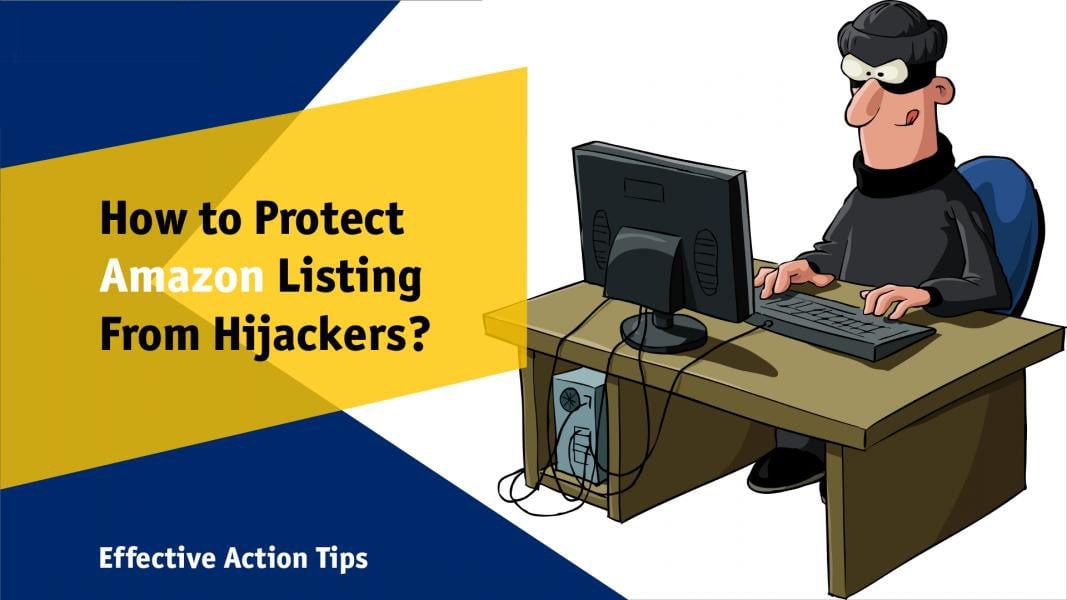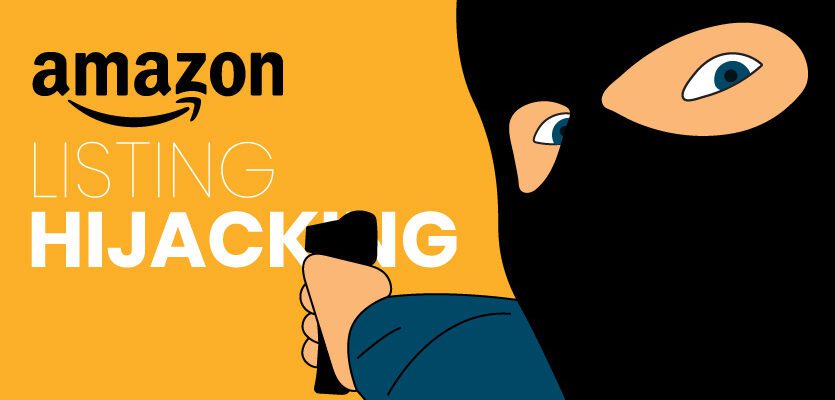Table of Contents
 Amazon hijackers are one of the most annoying problems that any entrepreneur who started selling on the Private Label model can face. In the article, we will review how to protect an Amazon listing from hijackers and answer the question of what to do if the attack on the listing (product) has already taken place.
Amazon hijackers are one of the most annoying problems that any entrepreneur who started selling on the Private Label model can face. In the article, we will review how to protect an Amazon listing from hijackers and answer the question of what to do if the attack on the listing (product) has already taken place.
What is Amazon Hijacking?
Amazon listing hijacking happens when someone sells counterfeit items or resells branded products purchased from you on your Amazon listing. Usually, they buy a unit of an original good, copy them, and then sell counterfeits at a suspiciously low price. Or, if you give out products for reviews, they purchase the units and then sell them on your Amazon business listing for a higher price.
What’s next? Imagine this: an unsuspecting shopper buys your product. However, instead of getting an original unit from you, the following happens. The hijacker takes over the Buy Box, gets the sale, and the client receives counterfeit products. Then, disappointed with the poor quality of the purchase, they leave negative feedback on your listing. As a result, you get a bad review for something that you don’t even offer, discouraging future users from buying your products on Amazon. Sounds frustrating, doesn’t it?

How is an Amazon hijacker different from a regular Amazon seller?
Hijackers can be Chinese manufacturers or suppliers, sellers from Alibaba or Aliexpress, sellers of counterfeit products, or even bots that work according to a certain algorithm and automatically get attached to other people’s listings.
Hijackers on Amazon can be divided into several types, but you need to understand that the division here is quite conditional.
- The Imposter. They often gain control of your listing to sell the same product but cheaper. When it comes to sales of goods available in the US retail network or on a large number of online platforms, this model of business is called dropshipping. In turn, we are talking about the Private Label model, where goods on Amazon product listing are unique and usually belong to only one entrepreneur or his team.
- The Counterfeiter. Their purpose is to sell low-quality counterfeit products through your listing. And this is one of the worst-case scenarios of Amazon hijacking, because thanks to such sales, negative reviews will soon pour into the listing, lowering the product rating to the very depths of Amazon’s search results.
- The Saboteur. They certainly haven’t come to make money directly on your listing. Their purpose is not to let you earn, neither now nor in the future. Having control over the listing, such a scammer can change the titles, descriptions, photos of the product and even write many fake negative reviews.
How to spot an Amazon hijacking listing?
Following are the few signs that reveal Amazon listing hijacking:
- Someone claims the Buy Box for your listing of products.
- Someone who is not your licensed reseller starts trading on your listing.
- Shoppers start posting negative or out-of-the-ordinary reviews on your listing.
A more convenient method to spot Amazon hijackers is using an online monitoring tool like SellerSonar. With it, you don’t need to check your Amazon listings manually and spend tons of time. Instead, you will get an instant notification as soon as the potential hijackers enter your listing.
Unfortunately, everyone who trades on the Amazon site has to deal with hijackers from time to time. This is the sad reality. However, by implementing a strategy aimed at preventing hijackers from appearing on your listing, as well as implementing an action plan to deal with them in the event of an attack, you will protect yourself from the risk of loss of profit and all the inconveniences that result from it! Read below to learn how to make your selling on Amazon protected.
How to remove Amazon hijacking from my account?
Let’s take a look at a few tactics to curb the actions of hijackers in case your Amazon account is stolen:
- Send a cease and desist letter.
If the hijacker is new to stealing other people’s listings, sending threatening letters might work. Later on, wait 24 hours in the hope that the hijacker will change his mind and disappear by itself. If this does not happen, then proceed to step №2.
- File a complaint of Trademark Infringement.
Try making infringement claims if you have previously registered in the United States the rights to the following: design patent, trademark, listing copyright.
- File a complaint to the seller (in our case, a hijacker)
To complain about another Amazon reseller, follow these steps:
- Seller Central> Help> Contact Us
- Next: Selling on Amazon> Other Issues> Report a Violation
Don’t write much. Briefly and in essence describe the situation: Your product is sold by another Amazon seller or even multiple sellers who did not receive from you the right for resell. Therefore, you suspect that they are selling counterfeit goods, endangering both your reputation and the reputation of Amazon.
- Buy hijacker’s goods
Purchase the goods from a hijacker that is trying to sell your products either from another account or through friends. Wait for the delivery and take a few photos that prove that the goods do not match the description and do not contain the logos of your Private Label. If the hijackers somehow managed to copy your logo – try to take a photo so that the logo is not visible. Or use Photoshop.
Then, on behalf of the buyer, complain to the seller (in our case, a hijacker) about the fake product. The next day, open A to Z Claim with a counterfeit complaint or contact Amazon Support with the same issue. At the same time, claim a refund for your purchase. Be sure to use the expressions “fake”, “not authentic”, and “counterfeit”.
After you have gone through all the points – wait for 24-48 hours to see the results of your battle with the hijacker.
How to prevent Amazon listing hijacking?
- Amazon Brand Registry – the answer to many problems.
One of the most common methods of Amazon preventing private label hijacking is to register your brand. Such a feature is available to those sellers who produce or sell their own product under their own brand.
- Brand your product.
Place the logo of your Private Label on the packaging and on the product itself. Make the logo so obvious that the buyer can immediately distinguish the counterfeit from the original.
- Constant control of listings.
View your listings regularly, but not only through Seller Central but also through the search bar on Amazon itself. Your task is to see the listing as your client purchasing the product sees it. If you have hundreds of products and thousands of variations – first of all, track the condition of those products that sell well. They can be the target of hijackers. Outsiders are of little interest to them.
Amazon product listing hijacking: final thoughts
Dealing with Amazon hijackers is an unfortunate side of working on Amazon. There always will be people striving to prey on others’ success as well as turn a quick dollar anywhere they go.
On the other hand, worrying about these people shouldn’t become your main priority. Just follow the steps above, and keep on moving towards creating a strong brand with high-quality products and well-thought-out marketing strategies. With SageMailer, you can get more positive product reviews and communicate with clients directly to minimize the negative impact of hijackers, if so, and boost the performance.


very helpful advice to use online monitoring tools!
I hate time-consuming options
excellent information, thanks;)